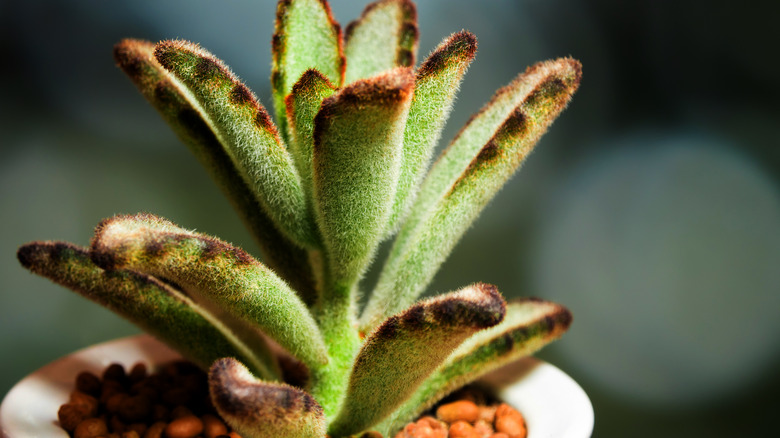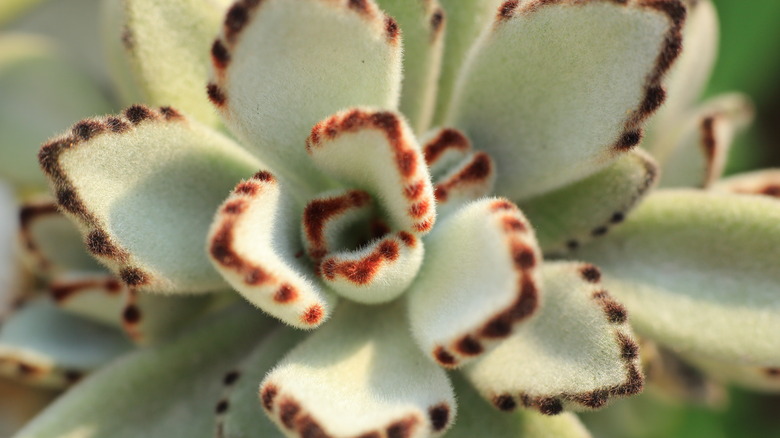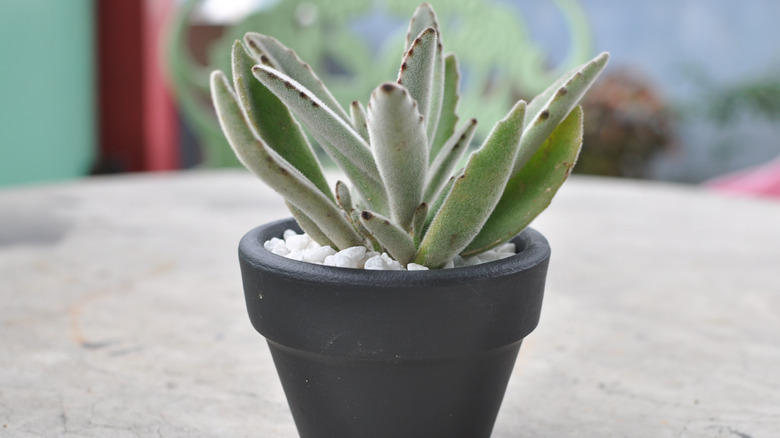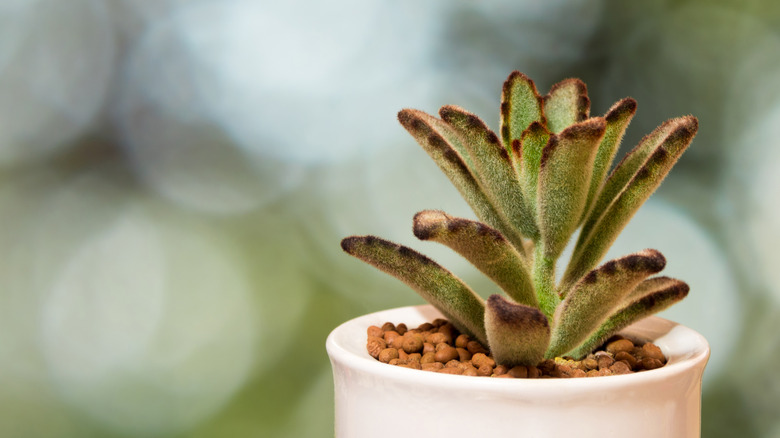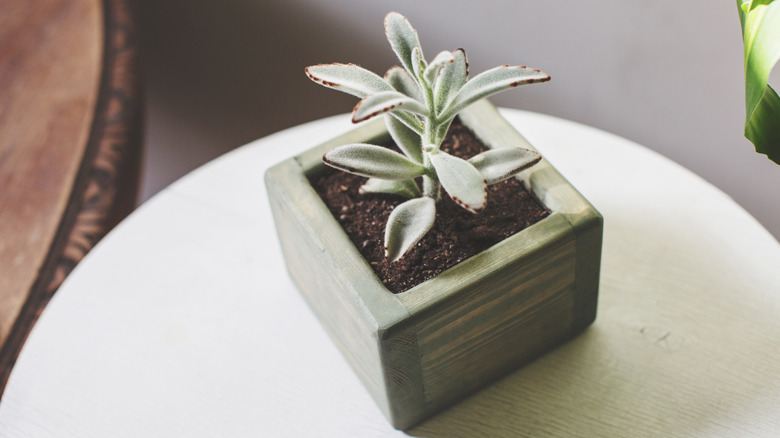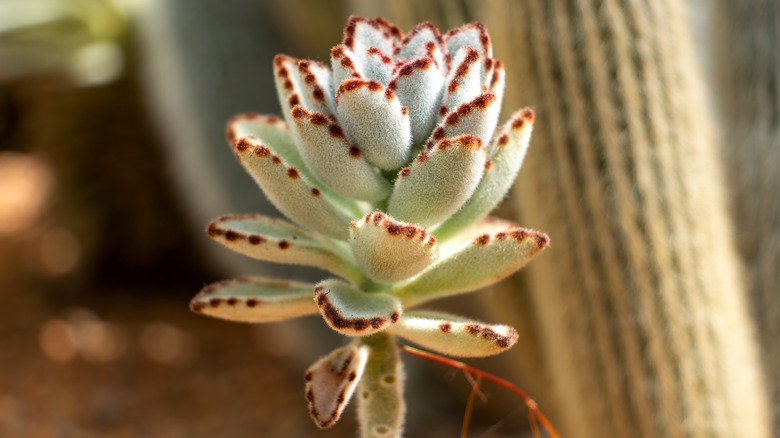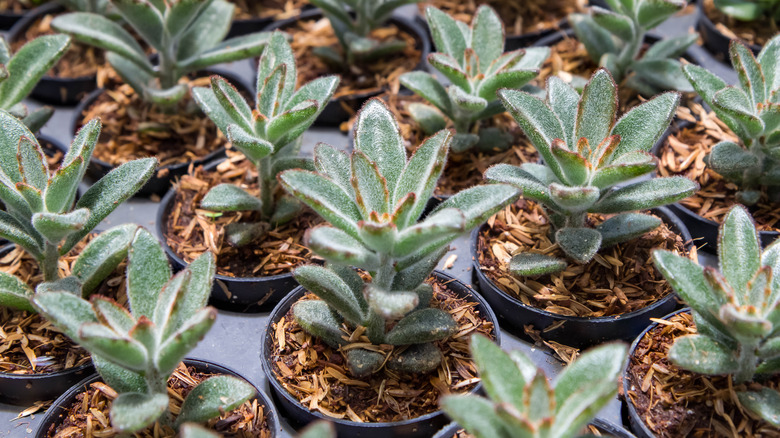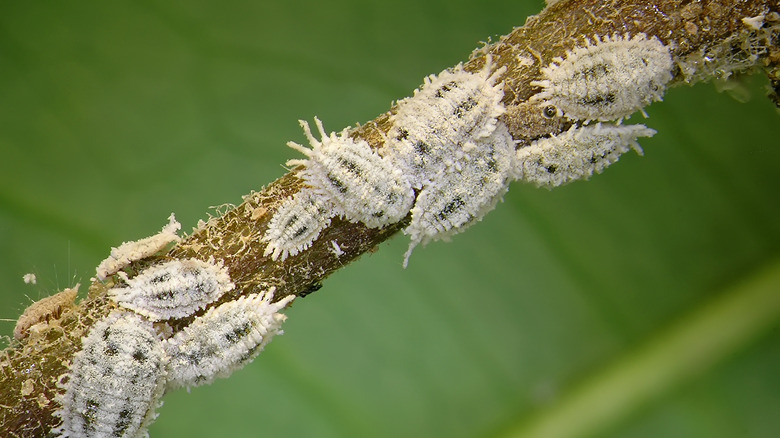How To Care For A Panda Plant
Panda plants (kalanchoe tomentosa) are a very popular and unique-looking succulent with fuzzy, light sage green leaves shaped like ears and dotted with brown along the edge — hence the name. The panda plant is also commonly referred to as the chocolate soldier plant, velvet leaf kalanchoe, plush plant, teddy bear cactus, and the cocoon plant, according to The Spruce.
Native to Madagascar, the succulent is most commonly grown as a houseplant due to the specific heat and humidity needs it requires for consistent outdoor growth. However, when grown in the right conditions outdoors, it can grow little red flowers. Whether grown indoors or out, it will still be a beautiful addition to your home, patio, or garden. This is a very easy kalanchoe to care for and maintain, with Succulents and Sunshine recommending this plant as a great one for beginners. Keep reading to learn more about the needs and growth conditions of this unique-looking, fuzzy succulent.
How to use panda plant in garden
Panda plants are not typically grown outdoors, but they can be given the right conditions. Unlike other plants, it's not generally recommended to take them outside during the summer — for as much as they don't like being cold, they don't like being too hot. House Plants Expert recommends keeping them in conditions between 60 and 75 degrees, which roughly includes USDA hardiness zones 9a through 11b (per The Spruce).
When planted outdoors, they prefer full sun to partial shade, but those in hot and arid climates like deserts should lean more towards shade, as the hot sun can damage the plant, warns Gardenia. The panda plant can grow up to 3 feet tall and wide, which gives you a few options when using them in landscaping. For those who may not live in the exact right climate, they can be grown annually in container arrangements. In-ground, they are great for bordering areas of your garden, or as ground cover. They are also great for succulent or Mediterranean gardens. As for companion plants, consider stonecrop, crown of thorns, flaming Katy, or echeveria 'Lady Aquarius.'
How to grow panda plant
Since panda plants are so visually interesting and easy to care for, you may find yourself wanting another one. Don't rush to the nearest garden center just yet, though, because this succulent can be very easily propagated. Propagating succulents is a little bit different than a regular house plant, but it's not that daunting once you know what to do.
Succulents Box recommends taking a stem cutting during spring, the plant's growing season. To do this, use clean and sharp shears or scissors to cut the stem off a healthy and mature plant. The stem should have a couple of leaves and nodes. You can also cut off just a leaf, but the stem will be more successful and root quicker. Instead of immediately rooting in soil, let it dry out for a few days and develop a callus over the cut — succulents store water in their leaves, so letting it dry out prevents root rot.
Once the callus develops, get a small pot and fill it with cactus or succulent potting mix. Dip the cut end of your cutting into a rooting hormone powder, and add it to the soil. Give it a few weeks in a sunny area, keeping it moist by spraying it with water semi-frequently. Then, gently tug on the plant. If it resists, the roots have developed, and you can care for it like a regular plant.
How to care for panda plant
Caring for panda plants is similar to caring for most succulents, which means there is very little effort required on the part of the gardener. In fact, some people have issues keeping succulents alive due to how little care they need, as they end up doing too much and overwhelming the plant. Remember, less is more when it comes to caring for drought-tolerant succulents.
For the panda plant specifically, they should be watered very infrequently. As stated earlier, it's important to remember that succulents store water in their leaves, and watering too frequently will lead to root rot., warns MasterClass. You should only water when the soil is completely dry and crumbly to the touch. They don't have any specific humidity or care needs, just keep them at an average room temperature and away from drafts and vents. This succulent is comfortable in most lighting conditions. Panda plants can definitely benefit from frequent fertilizing. Feed monthly during their growing season (early spring through late summer) with a succulent specific liquid fertilizer.
Panda plant varieties
Panda plants are a species of the kalanchoe genus, which includes 125 total flowering succulents, according to Kalanchoe Succulent. Most kalanchoe have similar requirements in terms of care, so after you nail the routine for your panda plant, consider getting a few more members of the kalanchoe genus. Here are just a few from Balcony Garden Web:
-
Chandelier Plant (Kalanchoe delagoensis) — This variety is popular for its bright coral colored bell-shaped flowers that grow down in a shape similar to a chandelier.
-
Kalanchoe 'Wendy' — This species grows flowers similar in shape to the Chandelier Plant, but a little wider and fuller and in a deeper fuschia shade.
-
Kalanchoe luciae 'Oricula' — This succulent is very unique looking, growing leaves in coral shapes, with leaf colors ranging from a basic green to a vibrant orange.
-
Milky Widow's Thrill (Kalanchoe laxiflora) — This kalanchoe variety grows in small little rosette-shaped spirals, and when they flower, they bloom skinny bell-shaped pink flowers.
-
Walking Kalanchoe (Kalanchoe synsepala) — This species gets its common name due to the offshoots it juts out, which make it look like it's walking.
Is the panda plant toxic?
All species of the kalanchoe genus are toxic to cats, dogs, and humans, according to the ASPCA. In animals, there is a chemical present called bufadienolides, which, when ingested by pets, leads to general gastrointestinal upset — vomiting, diarrhea, etc. That being said, bufadienolides can also affect the heart and, when ingested in large quantities, can lead to an irregular heartbeat and other severe symptoms, warns Pet Poison Helpline, which rates the plant as mildly toxic. Keep the plant out of reach of pets, but if they manage to get into it, call their vet immediately. Some kalanchoes are more toxic than others, so bring in your panda plant to the visit so they can run tests (if necessary).
Panda plants are also toxic to humans and should be kept away from small children (via Missouri Poison Center). While the worst cases of kalanchoe poisoning in humans have only resulted in gastrointestinal irritation, it should still be avoided. If you or someone else accidentally eats the plant, drink lots of water to flush it out. Also, consider calling the doctor or a poison control center if symptoms worsen past vomiting and diarrhea.
How to repot panda plant
Panda plants should be repotted roughly every two years or so, advises MasterClass. This is for two reasons — one, the roots are growing out of the bottom and top of the pot, indicating the plant is becoming root bound, and two, the plant needs fresh soil and nutrients.
Begin repotting by sliding the plant out of its current pot and, using your hands, gently breaking up the packed dirt and root system. Massage out as much dirt as possible, and then assess the roots. Remove any old, mushy, or moldy roots. Then, prepare the new pot. The Spruce recommends a terracotta pot, as the material absorbs excess water and prevents root rot, but any pot with adequate drainage holes will do. If the plant has outgrown its old pot, get one no more than a couple of inches larger.
As the panda plant is a succulent, it will prefer dry and well-draining soil. A premixed cactus or succulent specific potting mix will do just fine, but you can also mix in sand for extra drainage (per House Plants Expert). Add a small layer to the new pot, and then add the panda plant, making sure it sits at the same depth as it was previously. Fill with soil, water thoroughly to expose air pockets (and fill those), and let drain.
Common panda plant pests
Succulents, and panda plants particularly, are susceptible to mealybug infestations, warns MasterClass. Mealybugs may not be that noticeable, especially on the fuzzy panda plant. They show up as little cotton-like bits on the underside of leaves, usually when the plant is overwatered, according to Succulents Box. Once they show up, treat immediately, as eggs hatch in as little as six days, with female mealybugs laying upwards of 600 eggs a day.
Begin by quarantining your panda plant from all other plants, as mealybugs can spread out very easily. Remove your plant from its pot, and deep clean the pot with hot water and a strong disinfectant soap. Run your plant under a stream of super hot water, and once the pot and plant are both dry, repot. To kill the remaining mealybugs, spray them down with rubbing alcohol, which will cause them to turn brown and die. Do this as much as you need to — don't worry, this won't hurt your panda plant. Neem oil can also be sprayed at the soil to kill and prevent mealybugs from nesting there. If no mealybugs are present after a few weeks, you can return it to its original spot. Do a thorough check on other nearby plants to make sure there aren't any mealybugs on them, even applying neem oil just to be safe.
